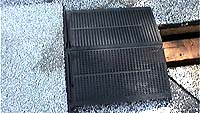 |
 |
 |
| |
 |
 |
 |
 |

If you read the article on duct sealing, you already know how extreme attic temperatures can get. As a reminder:
On a hot summer day, the attic temperature can reach 140°F (60°C) when the outside temperature is some 95°F (35°C) primarily due to solar radiant heating.
Building officials have come up with minimum guidelines to
attic ventilation. The common reference is for every 150 sq. ft. (14 sq. m) of attic floor space (usually the same
as the living floor space), 1 sq. ft. (0.10 sq. m) of ventilation is needed.
Special circumstances allow for less ventilation, but this is a safe number.
Ventilation includes: roof vents, turbines, soffit vents, ridge vents, and
eave vents. In this example, continuous ridge vents are applied on the hips
and ridges of a typical roof. A 1.5 in (38mm) slot is cut at the edges of
the roof, then covered over with vents. The type of vents I used form a decorative
architectural roofline, similar to thick hip and ridge shingles.
is for every 150 sq. ft. (14 sq. m) of attic floor space (usually the same
as the living floor space), 1 sq. ft. (0.10 sq. m) of ventilation is needed.
Special circumstances allow for less ventilation, but this is a safe number.
Ventilation includes: roof vents, turbines, soffit vents, ridge vents, and
eave vents. In this example, continuous ridge vents are applied on the hips
and ridges of a typical roof. A 1.5 in (38mm) slot is cut at the edges of
the roof, then covered over with vents. The type of vents I used form a decorative
architectural roofline, similar to thick hip and ridge shingles.

| Consulting | Digital Lifestyle | DVD Guide | Green Living | Building Hints | Product Tips |
| OS X updates | Free Newsletter | Pricing | Home | Contact | Site Map |
| Search | |||||
|
Copyright © 1997-2006 Green Building Concepts. All rights
reserved. Please click here for the Terms and Conditions of Use applicable to this site. Use of this site signifies your acceptance of the Terms and Conditions of Use. Direct all questions and comments about the web site to | |||||